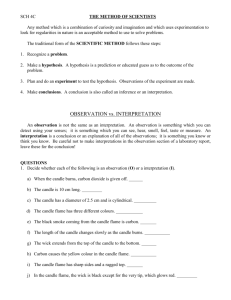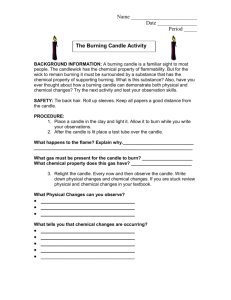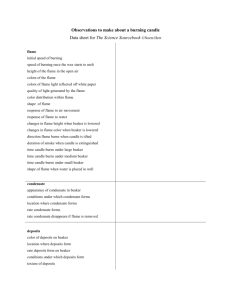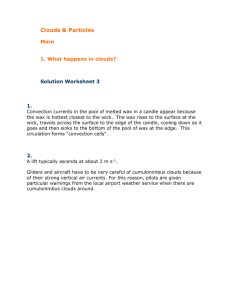Light a candle - Science Learning Hub
advertisement
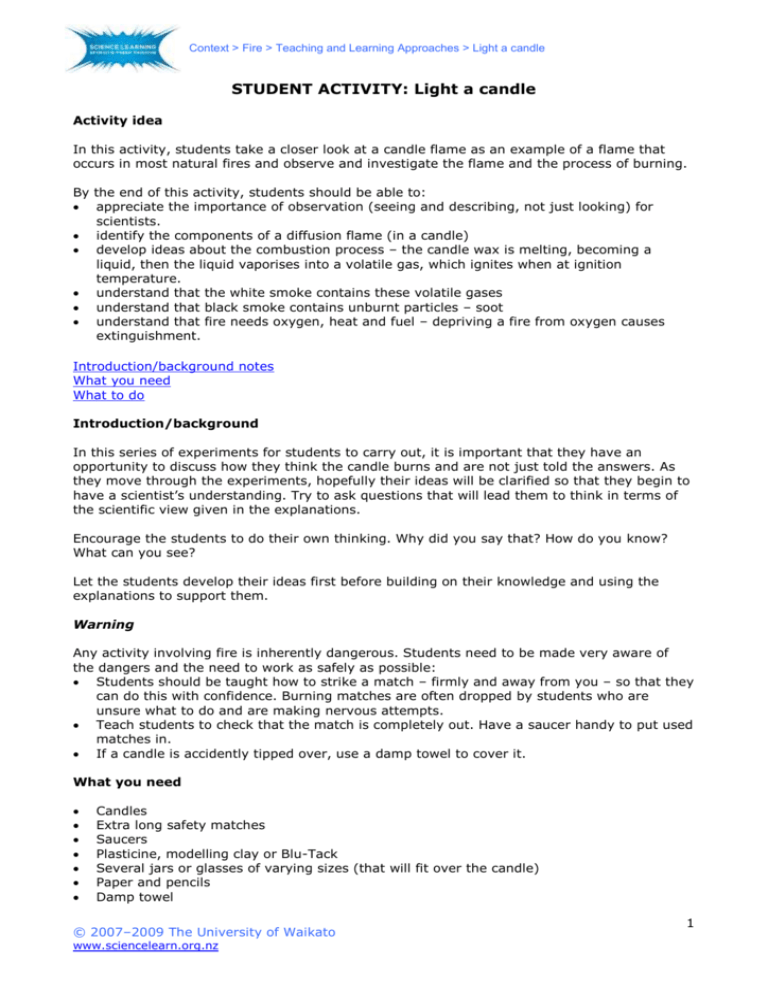
Context > Fire > Teaching and Learning Approaches > Light a candle STUDENT ACTIVITY: Light a candle Activity idea In this activity, students take a closer look at a candle flame as an example of a flame that occurs in most natural fires and observe and investigate the flame and the process of burning. By the end of this activity, students should be able to: appreciate the importance of observation (seeing and describing, not just looking) for scientists. identify the components of a diffusion flame (in a candle) develop ideas about the combustion process – the candle wax is melting, becoming a liquid, then the liquid vaporises into a volatile gas, which ignites when at ignition temperature. understand that the white smoke contains these volatile gases understand that black smoke contains unburnt particles – soot understand that fire needs oxygen, heat and fuel – depriving a fire from oxygen causes extinguishment. Introduction/background notes What you need What to do Introduction/background In this series of experiments for students to carry out, it is important that they have an opportunity to discuss how they think the candle burns and are not just told the answers. As they move through the experiments, hopefully their ideas will be clarified so that they begin to have a scientist’s understanding. Try to ask questions that will lead them to think in terms of the scientific view given in the explanations. Encourage the students to do their own thinking. Why did you say that? How do you know? What can you see? Let the students develop their ideas first before building on their knowledge and using the explanations to support them. Warning Any activity involving fire is inherently dangerous. Students need to be made very aware of the dangers and the need to work as safely as possible: Students should be taught how to strike a match – firmly and away from you – so that they can do this with confidence. Burning matches are often dropped by students who are unsure what to do and are making nervous attempts. Teach students to check that the match is completely out. Have a saucer handy to put used matches in. If a candle is accidently tipped over, use a damp towel to cover it. What you need Candles Extra long safety matches Saucers Plasticine, modelling clay or Blu-Tack Several jars or glasses of varying sizes (that will fit over the candle) Paper and pencils Damp towel © 2007–2009 The University of Waikato www.sciencelearn.org.nz 1 Context > Fire > Teaching and Learning Approaches > Light a candle What to do 1. In small groups, have the students secure a candle to a saucer with modelling clay, plasticine or Blu-Tack, then light the candle and observe the flame and the zones within it. 2. Ask them to draw what they see and note the colours. (An observation always takes into account what the object or substance, looks, feels and smells like originally and notes any changes that occur over time.) 3. Within their groups, have the students discuss the appearance of the flame and the parts or zones they can see. What do you think is happening in the burning process. What is the position of the wick? Why isn’t it destroyed in the burning process? What might be the purpose of the wick? (At this stage, it is best to ask questions and encourage the students to really observe and discuss what is happening rather than to impose a scientific view. However, at some stage, you may wish to clarify some of their thinking.) Explanation The yellow and blue zones are the flame. Complete combustion is occurring at the blue flame (the hottest part) – it has access to a lot of oxygen. Incomplete combustion occurs with the yellow flame. Glowing soot particles are what produce the yellow colour. The dark zone is an area of gases from the wax and is oxygen deprived. There are intermittent reactions in this area. The wick is designed to curve so that the flame ‘clips’ off at the wick and limits its height. What is happening in the burning process? The heat of the flame melts the wax; the melted wax soaks the wick (by capillary action), evaporates and becomes gas to diffuse into the luminous zone where it finds oxygen. Gas molecules fragment and rejoin with oxygen as combustion takes place. This process is sustained by the constant supply of heat. The temperature of the blue part of the flame has to be more than 1,300°C to sustain the reaction. 4. Have students bring a live match close to the flame until it bursts into flame. Repeat with a dead match. Why was the live match quicker to ignite than the dead one? Explanation The radiated heat from the candle causes the molecules in the match wood to vibrate faster and faster until gases are produced (which react with oxygen) and it ignites. The same thing happens with the live match head, except it has chemicals that react with heat to speed up the ignition process. 5. Extinguish the candle and immediately hold a burning match in the smoke wafting up from the candle. What happens? Why? What colour was the smoke? What might be causing it? Explanation The smoke contains gases from the wax. If heat is applied to the smoke, the gases react with oxygen causing ignition. © 2007–2009 The University of Waikato www.sciencelearn.org.nz 2 Context > Fire > Teaching and Learning Approaches > Light a candle 6. Predict what will happen if you put a dead match across the flame, then carry out the task and observe the results. Why did the match ignite? What colour is the smoke? Why? What is it? Where did it come from? 7. Predict what will happen if you put a saucer just above the candle flame, then observe the results of doing so. What is collected on the saucer? Where do these black particles originate? Explanation The black smoke results from incomplete combustion. It contains unburnt particles from the wax known as soot. 8. What happens if a jar is placed over the burning candle? (Try different sized jars.) Discuss with your group the possibilities of what might be happening. One person from the group could present the group’s ideas to the class. Explanation Combustion is chemical change. Oxygen reacts with wax vapour to produce a mixture of products that include carbon dioxide and water molecules. As the candle continues to burn, the oxygen gas is being used up to produce the carbon dioxide and water molecules. At some point, there is not enough oxygen to keep the chemical reaction going so the flame stops. The flame going out could be partly due to the build up of carbon dioxide and partly due to the lack of oxygen. © 2007–2009 The University of Waikato www.sciencelearn.org.nz 3
